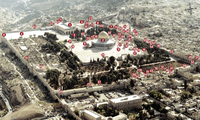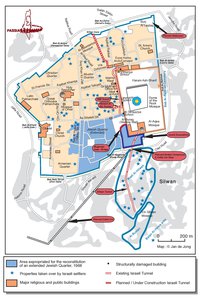SETTLEMENT ACTIVITY IN THE OLD CITY
Map Details
The creation of an extended Jewish Quarter within Jerusalem’s walled Old City occurred at the expense of over 6,500 Palestinian residents, who were summarily expelled from it between June 1967 and April 1968. The artificially imposed Quarter was constructed on the ruins of demolished Palestinian properties with little regard for the Old City’s predominantly Mamluk-era (13th-15th Century) architecture. As a result, the modern apartment complexes, parking lots, tourist observation platforms and boutiques of the Jewish Quarter clash with the aesthetics of the historic Muslim, Armenian and Christian Quarters. Like all Israeli settlements in occupied East Jerusalem, the Jewish Quarter is linked directly to West Jerusalem infrastructure and services, with the Nabi Daoud and Al-Magharbeh Gates serving as Jewish public transport terminals as well as checkpoints. Within the city walls, the Jewish Quarter’s ‘borders’ are not marked by checkpoints except in the eastern portion, which abuts the ‘Wailing Wall’ (Al-Buraq Ash-Sharif). Here stringent security checks limit Palestinian access to or through the disputed holy place and the site of the demolished Mughrabi Quarter. Beyond the limits of the expanded Quarter, settlers belonging to some of Israel’s more extreme racist movements have, since the mid-1970s, seized and occupied dozens of Palestinian properties. In doing so they have received the support – both in terms of legal ‘creativity’ and financial sponsorship – of successive Israeli governments and the WJM. Both, the current mayor of Jerusalem, Nir Barkat, and Prime Minister Netanyahu have been long-standing proponents of property seizures in and around the Old City, while former Prime Minister Ariel Sharon had himself ‘obtained’ a property deep in the Muslim Quarter. As of 2014, over 1,000 Jewish settlers live in the Muslim, Christian and Armenian Quarters, with the greatest concentration in the area of the Muslim Quarter adjacent to Al-Haram Ash-Sharif. In 2013, 3,329 Jews lived in the Old City, comprising a little over 8% of the total population - 39,865 - within the walls. The 30,328 Muslims (76%) represented the overwhelming majority, while Christians accounted for the remaining 16% (6,208), including 4,577 Christians of Palestinian origin and 1,631 Armenians. Of the four quarters, the Muslim Quarter is by far the largest, covering 480 out of the total 900 dunums that make up the Old City. In comparison, the Christian Quarter covers 192 dunums, the Armenian 126 dunums, and the Jewish Quarter's slight expansion since the 1967-1968 expropriations leaves it covering 122 dunums. Calculating the housing density of the Muslim Quarter after excluding the 135 dunums of Al-Haram Ash-Sharif, reveals the largest Quarter to be one of the most densely populated places on earth, with a rate of about 88 persons per dunum. As of 2014, the average rate for the four Quarters combined stands at 50.8 people per dunum (without the Al-Haram Ash-Sharif), while the rate in the modern Jewish Quarter is nearly half this, at 27.3 people per dunum. The rates in the Christian and Armenian Quarters are even lower, respectively, 23.8 and 12.9 people per dunum. Quarter Population Area (dunums) Persons per dunum 1 Including the 135 dunums of Al-Haram Ash-Sharif compound. If this area is not counted, the population density in the Muslim Quarter rises to 88.8! 2 Excluding over 1,000 settlers occupying houses in the Muslim and Christian Quarters. 3 Including the Al-Haram Ash-Sharif compound. If this area is excluded, the average population density rises to 50.8. Muslim 30,328 4801 63.2 Christian 4,577 192 23.8 Armenian 1,631 126 12.9 Jewish 3,3292 122 27.3 Total 39,865 920 43.333 Source: Jerusalem Institute for Israel Studies, Statistical Yearbook of Jerusalem 2013; previous editions. The Old City houses some 25 mosques, 65 churches and 20 synagogues. However, a survey conducted by Jewish, Muslim and Christian scholars in 2000, produced a catalogue of as much as 326 holy places within or just beyond the Old City walls, being places of worship, religious academies, monasteries, hostels, tombs and retreats. Of these, 108 are considered primarily sacred to Muslims, 154 to Christians and 64 to Jews. Israel’s pursuit of settlement within the walled city and its denial of free Palestinian access to the city of Jerusalem as a whole, and the Old City in particular, has increasingly limited the freedom of non- Jews to enjoy their basic right to worship. Policies preventing Palestinian access to holy sites in the Old City – including during the holy month of Ramadan or for Christmas and Easter services – are in absolute contravention of International Law. Since 1981, the Old City has been listed by UNESCO as a World Heritage Site. In 1999, UNESCO adopted a resolution demanding international investigation into Israeli violations of the Geneva and Hague Conventions in regard to Israel’s discriminatory policies pertaining to access and worship within the city. Notwithstanding this, Israel began to fit the Old City’s non-Jewish Quarters with up to 500 closed-circuit security cameras. Ostensibly for the ‘protection’ of the extremist settler groups living in these quarters, the installation of the monitoring system in the densely populated city, has only underscored the ethnic inequality inherent in Israel’s expansionist occupation of the ancient city and gives the lie to Israeli claims of a ‘unified’ Jerusalem.
Related Maps
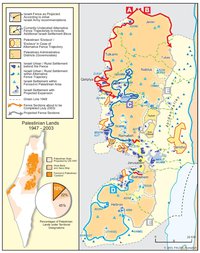
ISRAEL'S SEPARATION BARRIER, 2002
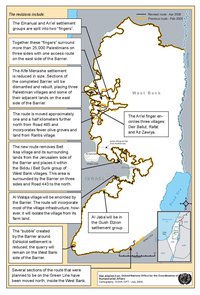
REVISED ROUTE OF THE ISRAELI SEPARATION BARRIER, 2006
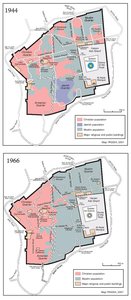
THE OLD CITY, 1944 & 1966
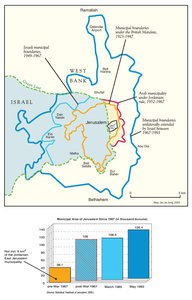
MUNICIPAL BOUNDARIES OF JERUSALEM, 1947-2000
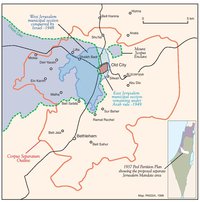
JERUSALEM AND THE CORPUS SEPARATUM PROPOSED IN 1947
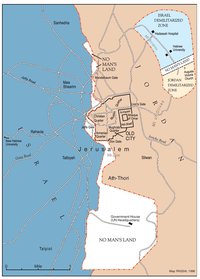
PARTITIONED JERUSALEM, 1948-1967
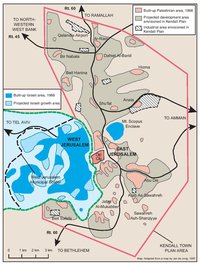
THE KENDALL TOWN SCHEME, 1966
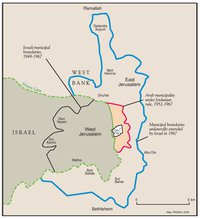
JERUSALEM AFTER THE 1967 WAR
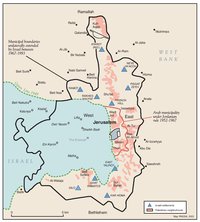
ISRAELI SETTLEMENTS AND PALESTINIAN NEIGHBORHOODS IN EAST JERUSALEM, 2000
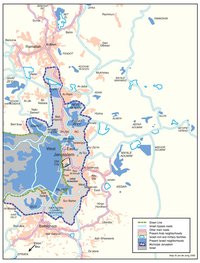
ISRAELI SETTLEMENTS AND PALESTINIAN NEIGHBORHOODS IN METROPOLITAN JERUSALEM, 2000
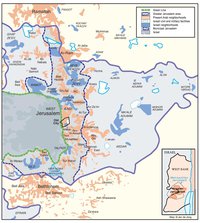
ARAB EAST JERUSALEM WITHIN ‘GREATER’ JERUSALEM, 2000
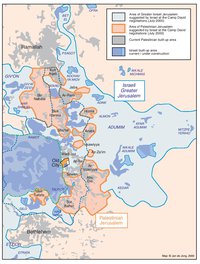
PROJECTION OF THE ISRAELI PROPOSAL FOR JERUSALEM’S FINAL STATUS AT CAMP DAVID, JULY 2000
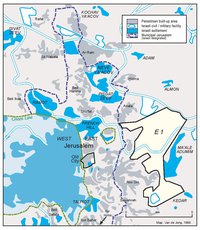
THE E-1 DEVELOPMENT PLAN
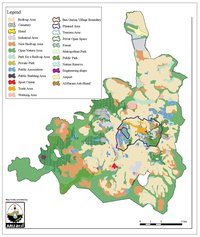
THE JERUSALEM MASTER PLAN
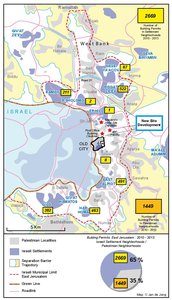
JERUSALEM TODAY (2014)
